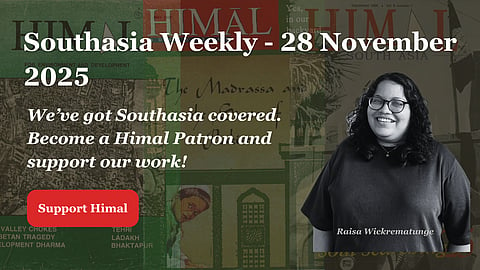DDLJ’s dubious 30-year legacy – Southasia Weekly #94
You may or may not have seen one or all of these news updates in the past week; an earthquake in Bangladesh that has already claimed ten lives, a cyclonic storm in Sri Lanka, airstrikes in Afghanistan, 22 student protesters detained for demanding clean air in Delhi, amid claims some of them shouted Maoist slogans. Each of these stories deserves space and attention. But for us, talking about Myanmar took precedence this week, given the US government’s claims that the country is “safe” to justify ending protections for thousands of refugees in the US.
On the contrary, the news updates I’ve been seeing have shown a steady stream of reports of airstrikes, temporary and tense ceasefires and fleeing refugees losing their lives at sea. And while most international news organisations will report this story as simply part of the US’s plans to crack down on immigration, our focus is on civilians caught in the middle. We aim to bring you a grounded perspective on the news, week-on-week. But we’re a small team, and we need your support to keep going.
Due to regulatory restrictions on processing recurring payments for Indian credit and debit cards, we are unable to offer monthly Patron plans to subscribers in India. You may instead opt for one of our one-time payment plans listed here.
This week in Himal
Anna Vetticad writes about the Hindi film Dilwale Dulhania Le Jayenge and its dubious legacy, with its ultra conservatism paving the way for misogyny and Hindu nationalism in Indian cinema 30 years later.
On the Saffron Siege podcast series in collaboration with Karwan-e-Mohabbat, historian Purushottam Agrawal examines the RSS’s seething resentment towards India’s first prime minister Jawaharlal Nehru and more.
Coming up on the Southasia Review of Books podcast hosted by Shwetha Srikanthan, a conversation with writer and filmmaker Nirvana Bhandary on Unsanskari: A Feminist Life, a collection of essays on what it means to be a Nepali woman beyond traditional expectations and patriarchal norms.
Do you enjoy community-building? We’re on the lookout for an Audience and Engagement Manager. More details on how to apply here.
From 30 November to 8 December, Chaitanya Consultancy is hosting “The Southasia Lectures” themed on climate policy and climate justice. View the full programme here and register to attend the lectures here.
This week in Southasia
On 24 November, the US government announced the end of Temporary Protected Status for refugees from Myanmar, impacting around 4000 people in the US who face the threat of deportation. The US government cited elections planned by the junta regime as proof of the situation improving in Myanmar, despite widespread criticism that the elections are being held to legitimise military rule. On 27 November, 3000 political prisoners were released from Insein Prison as part of an amnesty programme to allow more people to vote, state-run broadcasters said. But Myanmar-based advocacy groups report 982 air strikes between March and June, with mass detentions and thousands of people killed as Myanmar’s military takes on anti-junta armed groups.
In the past month, the junta has taken back territory thanks to relentless air-strikes and China’s intervention to broker ceasefires with anti-junta groups, most recently in Lashio and Mandalay. The ceasefires reveal how China is increasingly shaping Myanmar’s civil war to further its own economic and geopolitical interests. Our interview with Aung Kaung Myat from 2023 has more context on this - scroll down to the archives section to read it.
For the US, ending Temporary Protected Status for Myanmar nationals is part of broader plans to reduce immigration (in July, the US also sought to end Temporary Protected Status for Afghan refugees, citing similar justifications). But civilians returning to Myanmar are likely to bear the brunt of ongoing violence, while the junta may struggle to hold elections across the country in 2026 given that anti-junta groups hold large swathes of territory.

